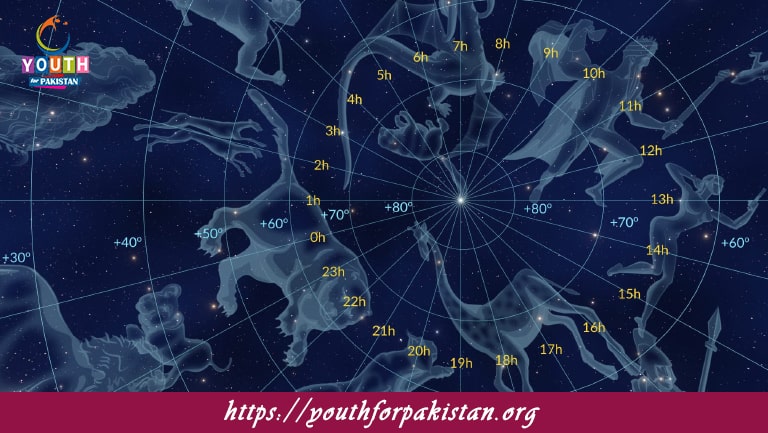Welcome to the Celestial Coordinates MCQs with Answers. In this post, we are sharing Celestial Coordinates Multiple Choice Questions and Answers in Astronomy section for various competitive exams in Pakistan. Each question offers a chance to enhance your knowledge regarding Celestial Coordinates online MCQs Test.
Which celestial coordinate system is most commonly used by astronomers?
a) Altazimuth system
b) Equatorial system
c) Galactic system
d) Ecliptic system
In the equatorial coordinate system, what does declination measure?
a) The distance of a star from Earth
b) The angular distance north or south of the celestial equator
c) The distance from the galactic center
d) The angle above the horizon
What unit is used to measure Right Ascension in the celestial coordinate system?
a) Degrees
b) Kilometers
c) Hours
d) Radians
The vernal equinox is the reference point for which celestial coordinate?
a) Declination
b) Ecliptic latitude
c) Right Ascension
d) Galactic longitude
The celestial equator is an extension of which terrestrial feature?
a) The Prime Meridian
b) Earth’s Equator
c) The Tropic of Cancer
d) The Arctic Circle
Which coordinate system is based on the plane of Earth’s orbit around the Sun?
a) Equatorial
b) Galactic
c) Ecliptic
d) Altazimuth
In the Altazimuth system, what does altitude represent?
a) The distance to a celestial object
b) The angle above the horizon
c) The position of the Sun at noon
d) The angular distance from the celestial equator
The north celestial pole is near which star?
a) Sirius
b) Polaris
c) Betelgeuse
d) Vega
Which coordinate system is used to describe the position of celestial objects relative to the Milky Way?
a) Equatorial
b) Galactic
c) Ecliptic
d) Altazimuth
What is the range of declination values in the equatorial coordinate system?
a) 0° to 90°
b) -90° to +90°
c) 0° to 180°
d) -180° to +180°
In the horizontal coordinate system, azimuth is measured from:
a) The celestial equator
b) The observer’s meridian
c) The horizon
d) The zenith
Right Ascension in the equatorial system is analogous to which Earth-based coordinate?
a) Latitude
b) Longitude
c) Altitude
d) Elevation
Which coordinate system is fixed to the observer’s location and changes with time?
a) Galactic
b) Horizontal
c) Equatorial
d) Ecliptic
What is the reference point for measuring declination in the equatorial coordinate system?
a) The North Pole
b) The vernal equinox
c) The celestial equator
d) The ecliptic plane
In the equatorial coordinate system, the declination of the celestial equator is:
a) 0°
b) 90°
c) -90°
d) 180°
The plane of the ecliptic is inclined by approximately how many degrees to the celestial equator?
a) 23.5°
b) 45°
c) 60°
d) 90°
Which celestial coordinate system is commonly used to track the motion of planets?
a) Galactic
b) Altazimuth
c) Ecliptic
d) Horizontal
Which term refers to the point directly overhead in the horizontal coordinate system?
a) Nadir
b) Horizon
c) Zenith
d) Meridian
The ecliptic longitude is measured from:
a) The vernal equinox
b) The celestial equator
c) The north celestial pole
d) The Milky Way center
Which of the following is a coordinate in the Galactic coordinate system?
a) Ecliptic latitude
b) Galactic latitude
c) Declination
d) Altitude
In which system is the position of celestial objects measured relative to an observer’s horizon?
a) Galactic
b) Horizontal
c) Equatorial
d) Ecliptic
What is the reference point for measuring Right Ascension?
a) The celestial equator
b) The vernal equinox
c) The galactic center
d) The Sun
What does azimuth measure in the Altazimuth system?
a) The altitude of a celestial object
b) The angular distance along the horizon
c) The declination of a star
d) The time since the object’s culmination
Which celestial coordinate system uses the center of the Milky Way as its reference point?
a) Galactic
b) Horizontal
c) Ecliptic
d) Equatorial
The altitude of the North Star (Polaris) in the sky corresponds approximately to:
a) The observer’s latitude
b) The observer’s longitude
c) The declination of Polaris
d) The vernal equinox
Which of the following coordinates changes depending on the observer’s location on Earth?
a) Right Ascension
b) Declination
c) Galactic longitude
d) Altitude
The celestial meridian is:
a) A line that runs from the North Pole to the South Pole
b) A line that divides the sky into eastern and western halves
c) A projection of Earth’s equator onto the sky
d) A point where the ecliptic intersects the celestial equator
The horizontal coordinate system is based on which of the following reference points?
a) The vernal equinox
b) The observer’s horizon
c) The Milky Way center
d) The Sun’s position
In the equatorial system, the zero point of Right Ascension is located at:
a) The North Celestial Pole
b) The Vernal Equinox
c) The Galactic Center
d) The South Celestial Pole
What does the term “sidereal time” refer to?
a) The time based on the Earth’s rotation relative to the stars
b) The time based on the Moon’s orbit around Earth
c) The time taken by Earth to orbit the Sun
d) The time measured from the vernal equinox
The ecliptic coordinate system is useful for observing:
a) Stars
b) Planets
c) Distant galaxies
d) Constellations
If you are interested to enhance your knowledge regarding Physics, Chemistry, Computer, and Biology please click on the link of each category, you will be redirected to dedicated website for each category.










